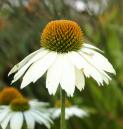Bistort. Snakeweed. Bistorte, Couleuvrine, Fr. Wiesenknöterich, Natterwurz, G.—This is the rhizome of Polygonum Bistorta, L. (Fam. Polygonaceae), a perennial herbaceous plant, growing in Europe and the north of Asia. The rhizome is cylindrical, somewhat flattened, about 1 to 2 cm. in thickness, marked with annular or transverse wrinkles, furnished with numerous rootlets, and folded or bent upon itself, so as to give it the tortuous appearance from which its name was derived. Externally it is dark purplish or blackish-brown. The fracture is nearly smooth, reddish or purple, the taste being astringent. It contains much tannin, some gallic acid and gum, and a large proportion of starch. H. K. Bowman found 21 per cent. of tannin in bistort root. (A. J. P., 1869, 193.) Its medicinal properties are like those of kino, but it is less efficient. It- may be employed in powder, decoction, or extract. The dose of the powder is twenty or thirty grains (1.3-2.0 Gm.).
Besides the bistort, some other plants belonging to the genus Polygonum have been used as medicines. Among these are P. aviculare, L., or knot weed, a mild astringent, formerly employed as a vulnerary and styptic; P. Persicaria, L., or lady's thumb, of a feebly astringent saline taste, and at one time considered antiseptic; and P. Hydropiper, L., common smartweed, or water-pepper, the leaves of which have a burning and biting taste, inflame the skin when rubbed upon it, and are esteemed diuretic, and have been used with asserted success in amenorrhea and other uterine disorders. Its irritant and also medicinal properties are due to an acid, polygonic acid, discovered by C. J. Rademaker. Polygonum Hydropiper has been used by Krawkoff (Russki Vratch, 1912) in the treatment of internal hemorrhages, especially of the uterus. He administered from thirty to forty drops of a fluidextract of the leaves. (A. J. P., xliii, 490.) The water-pepper or smartweed of this country—P. acre H. B. K..which grows abundantly in moist places, possesses properties similar to those of the European water-pepper, and is occasionally used as a detergent in chronic ulcers, and internally in gravel. B. Woodward found that the dried plant contains 18 per cent. of tannin, and used a saturated tincture with great advantage in diarrhea and dysentery, in doses of from twenty to sixty minims (1.3-3.75 mils). Aughey finds that P. amphibium, L., is readily cultivated, with a yield of from three to six tons to the acre, that the roots contain 21.75 per cent., the stems 17.1 per cent. of tannic acid, and urges the growth of it for tanning purposes. (N. R., 1876, 75.)
Fagopyrum esculentum Moench is common buckwheat. The leaves of this plant have been found by Ed. Schunck to contain a crystallizable coloring principle, identical with the rutin or rutic acid previously discovered by Weiss in the leaves of the common rue, and probably, with the ilixanthin of Moldenhaus, existing in the leaves of Ilex Aquifolium L., or the common holly. Buckwheat leaves yielded to Schunck somewhat more than one part of rutin in a thousand. (Chem. Gaz., No. 399, 201.)
From P. cuspidatum L. has been separated a glucoside, polygonin,, and also emodin. (P. J., Feb., 189,5.) The bark of the rhizome has been recommenced by Goris and Crete (Bull. Sci. Pharmacol., 1907) as a laxative. The leaves of the P. dumetorium are, according to Tunmann (Ph. Centralh., 1906), also practically useful as a laxative.
Various species of the genus Polygonum are used for the production of dye-stuffs; thus, indigo is obtained largely in China, Japan, and in some parts of Russia, from the leaves ofP. tinctorium Ait., and is said also to be yielded by those of P. aviculare and P. barbatum, L.;while in India, China, and Japan the roots of the P. cuspidatum are employed for making a yellow dye. (J. Chem. S., Dec., 1895.)

